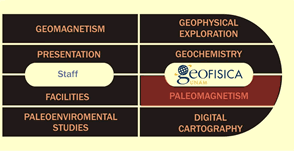Paleomagnetism
Group
Some of the main research lines are:
Rock Magnetism and Tectonics
The research studies are based on the magnetic properties characterization
of rocks and minerals in order to document the spatial and temporal
geomagnetic field changes in the past. The research is focused to
the origin and evolution of the geomagnetic field in order to develop
paleomagnetism applications in fields such as geophysics, geology,
archeology, as well as in mineral resources exploration and prospecting
Paleomagnetism and Tectonics
The paleomagnetic studies are one of the main tools in plate tectonics
and ocean floor spread research, since the paleomagnetic method allow
the measurement of movement of lithospheric plates and determine paleocoordinates
(referred to paleomagnetic poles). The interpretation of the ocean
magnetic anomalies, that jointly with radiometric dating, is the basis
of the geomagnetic polarity scale, has allowed the determination of
the age of the oceanic crust, as well as the velocity and direction
of movement of the lithospheric plates.
This research line is developed by us mainly in the study of continental
plates and its movement in the region of Mexico and Central America.
Our research is particularly focused on the tectonic and paleogeographic
evolution problems concerned with the Pangea super continent ensemble,
origin and evolution of Gulf of Mexico and Caribe region; the evolution
of California Gulf and Baja California Peninsula; as well as other
main geologic features such as East Sierra Madre, West Sierra Madre
and Volcanic transmexican belt. In the last years paleomagnetic studies
has been concentrated in research of the characteristics and process
involved in orogenic belts formation. Studies in deformed regions
in active margins and inside the continents have documented the occurrence
of block rotations along their vertical axis. Studies on accretion
terrane phenomena along continental margins and transform and transcurrent
failing process, have led to the development of tectonostratigraphic
terrane concept.
Magnetic properties of rocks and minerals
Some iron minerals such as loadstone, Ti poor titanomagnetites, hematite,
pyrrotite and goethite, are able to preserve a remanent magnetization,
which constitutes the basis of the paleomagnetic record in rocks.
The origin of remanent magnetization may be due to different process
such as temperature changes involved in magma cooling (plutonism and
volcanism) or in metamorphic processes. This research line is focused
to the study of the different remanent magnetization acquisition process
and characteristics of magnetization and magnetic minerals. The studies
also have a high potential for several applications such as modeling
and interpretation of magnetic anomalies, mineral ore and petroleum
fields prospecting, as well as for finding other secondary mineral
associations.
Geomagnetic field secular variation and
paleointensity
This research line is about the study of the geomagnetic field spatial
and temporal features and their intermediate period changes that are
in the paleosecular variations and in the documentation of the paleointensity
changes of the geomagnetic field. The study of the paleosecular variations
include studies of the historic period, starting from observatory
data and recent geological Periods, based on the records on volcanic
rocks, lacustrine sediments and archeological materials.







